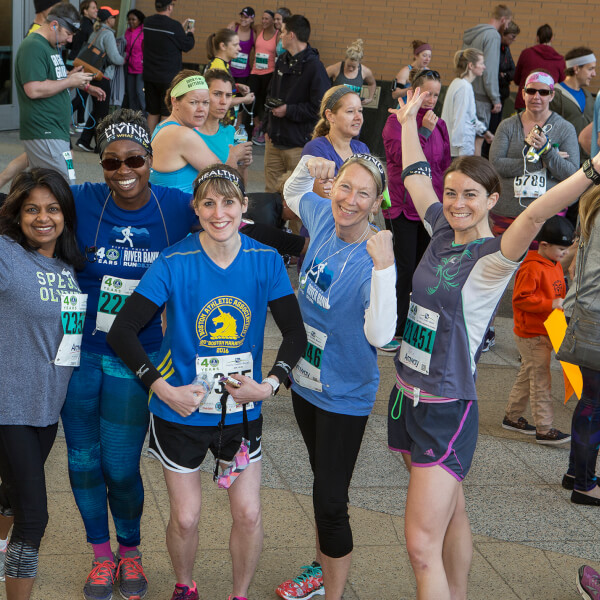
The sex difference in distance running has disappeared for participation but not for competitiveness

Even among contemporary U.S. distance runners, men are still much more likely than women to have a competitive orientation, according to researchers at Grand Valley State University in Allendale, Michigan. The findings were published in the online journal, Evolutionary Psychology.
The new research, led by Robert Deaner, associate professor of
psychology at Grand Valley, shows that, on average, American men
participate at track meets about three times as often as American
women, and this difference has been consistent since the late 1990s.
By contrast, at road races, the sex difference in participation has disappeared.
“The differing pattern of results at track meets and road races
is remarkable,” said Deaner. “Road races have grown tremendously in
popularity in the past few decades but most runners have a
recreational orientation, not a competitive one. This is shown in how
they answer questionnaires and in their generally slow performances.
They run for their mental and physical well-being and to socialize.
Track meets are completely different — there aren’t medals for every
finisher, they haven’t become popular, and the runners that do show up
almost always run fast.
Deaner said the results are interesting because they support the
idea that the disappearance of sex differences in sports motivation in
the U.S. is a myth, not reality. Since the passage of Title IX in
1972, girls and women have grown to comprise nearly half of
participants in organized high school and collegiate sports. However,
little research has tested whether this pattern reflects a decreasing
gap in sports motivation.
“When we look more closely at the data, there are still clear
indications that some sex differences in sports interest and
motivation remain large,” said Deaner. “Distance running is a perfect
example. Yes, women now participate in road races as much as men do,
but our results indicate that the small number of runners who have a
competitive orientation are still much more likely to be men.”
The new research focused on masters runners, who are defined as
being at least 40 years old. Deaner said masters runners were ideal
for the study because, unlike many distance runners in high school and
college, they aren’t motivated by external incentives, such as earning
a scholarship.
In Study 1, the researchers assessed participation and the
occurrence of relatively fast performances by masters runners at
hundreds of road races and track meets in the U.S. Fast performances
were defined relative to sex-specific, age-specific world records.
Fast performances occurred more than 20 times more often at track
meets than at road races. This pattern held for both male and female
runners, and it shows that participating at a track meet, but not a
road race, is usually a good indicator of having a competitive
orientation. Study 1 also found that women comprised 55 percent of
participants at road races but only 15 to 28 percent of participants
at track meets.
In Study 2, the researchers used data from national championship
meets and yearly rankings lists to test whether the sex difference in
masters track participation decreased from 1988 to 2012. Across all
years, women comprised 27 percent of participants in the national
championship meets and 22 percent of those individuals who appeared in
the yearly rankings. In both data sets, the sex difference decreased
across all 25 years, but only slightly. More crucially, there was no
evidence of a decreasing sex difference since the late 1990s.
Deaner acknowledged that the new studies have a major limitation
because they are based on patterns of participation, rather than
direct measures of motivation. He pointed out, however, that previous
studies support their interpretation that there is a sex difference in
competitiveness in distance runners.
“We actually have quite a bit of converging evidence.
Questionnaire studies find that, although most distance runners in the
U.S. do not have a competitive orientation, the ones who do are more
likely to be male,” said Deaner. “Other studies show that men are
roughly three times as likely as women to run fast relative to
sex-specific world class standards, and this is likely due, in part,
to their greater competitiveness and willingness to maintain large
training volumes. Also, we recently published a study demonstrating
that there is a robust difference in pacing in the marathon — men are
about three times more likely than women to slow down dramatically and
this probably reflects men’s greater inclination for risk taking, and
risk taking is a big part of being competitive.
“The take home message is that this new research complements
several other studies in showing that, although men and women are now
similar in terms of overall participation in distance running, they
still differ, on average, in their motivation. The most exciting
aspect of the new research is that we were able to test whether the
sex difference has changed over time.”
For more information, contact Robert Deaner at [email protected].
The study was co-authored by Vittorio Addona of Macalester
College and Michael Mead of Grand Valley State University.
Robert Deaner joined the Psychology Department at Grand Valley
State University in 2006. He earned a doctorate in biological
anthropology and anatomy at Duke University and conducted postdoctoral
research in the Department of Neurobiology at Duke. His research
focuses on applying evolutionary theory to human behavior and
investigating sex differences in performance and motivation.
Subscribe
Sign up and receive the latest Grand Valley headlines delivered to your email inbox each morning.








